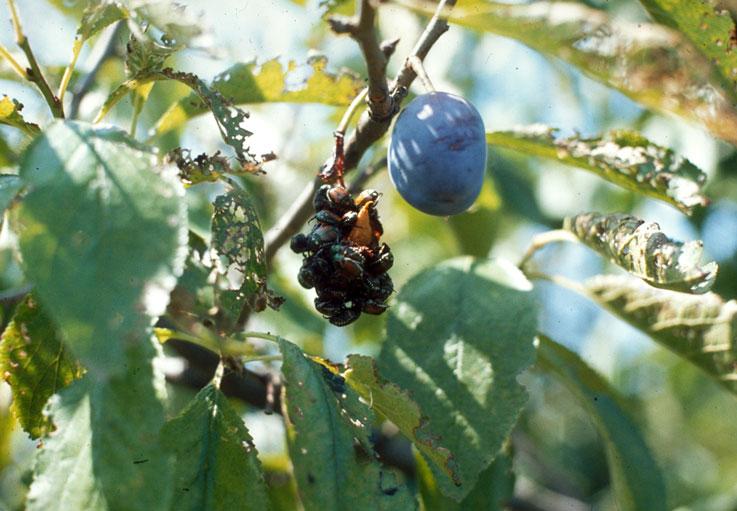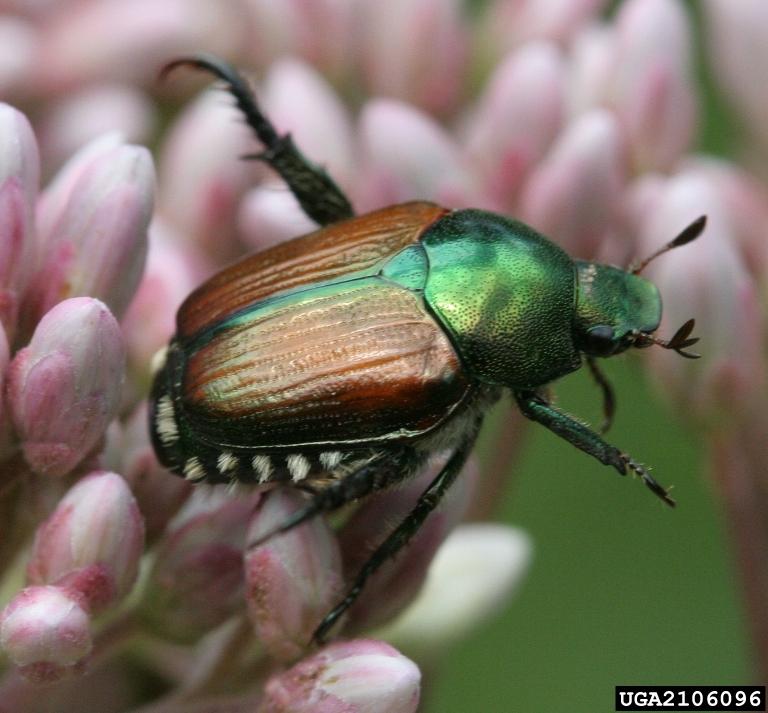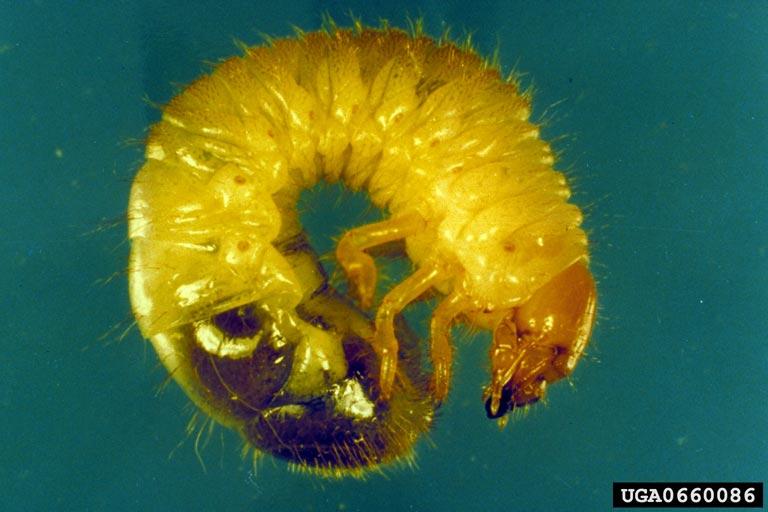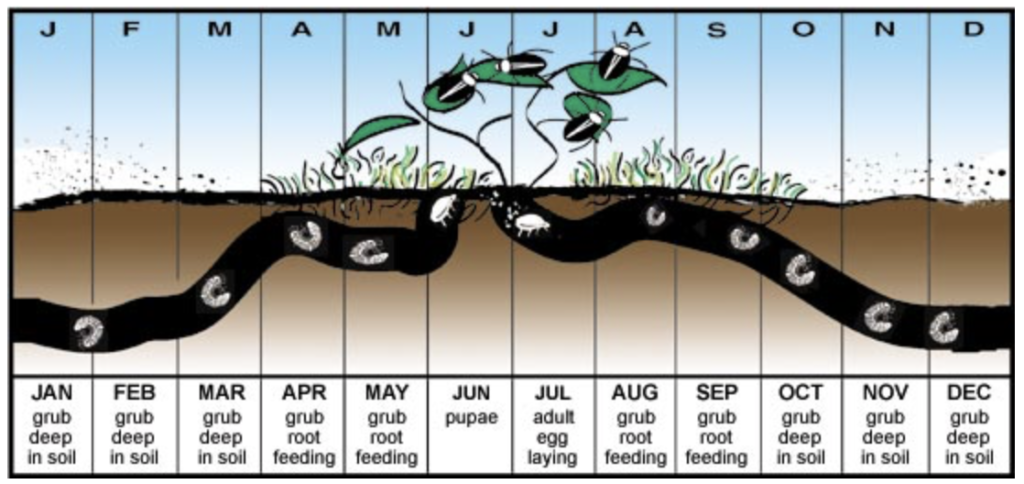What green, Japanese terror costs more than 200 million dollars in damage each year? No, it’s not Godzilla…it’s Popillia japonica a.k.a, the Japanese beetle (JB)!
This tiny import has entrenched itself as one of the most notorious garden and orchard pests in the United States, devouring acres of fields, trees, and shrubs each year.

Grower beware! — more than 300 plant species are susceptible to Japanese Beetles, including many POP orchard favorites like apples, grapes, apricots, cherries, plums, peaches, raspberries, and strawberries!
But, before you go fleeing the streets in response to its feedings of fury, here are a few ways you can combat this garden nemesis with proper knowledge of its life cycle, feeding habits, and some organic controls you might employ to outsmart this little bugger!

Identification
Adults
Both adults and grubs (larval stage) are problematic plant pests. Adults feed on leaves, flowers, and fruits, while grubs feed on roots.
Adults are about ½ inch long with distinct coloration. The head and thorax are metallic-green while the wings are bronze. Additionally, six small, white, hairy patches line the sides and back of the abdomen.
Adults are most active from late spring to midsummer. ‘Skeletonized’ leaves seen below are classic indicators of JB foraging. In orchards, JBs are particularly keen to feed on apples (Honeycrisp), blueberries (Bluecrop), and raspberries (Chinook and Heritage).


Grubs
Grubs prove harder to locate as they spend their time underground. However, noticeable brown patches on your lawn may warrant further investigation.
To search for grubs, dig a small hole a few inches deep near the edge of the damaged area. Grubs are about an inch long with a white-colored body and light-brown legs and head.
Look for active grubs from early spring to late autumn. During winter months they will hibernate in deeper soil.


Japanese Beetle Life Cycle

Understanding JB’s life cycle is key for timing the proper offense. Grubs overwinter 8-10 inches deep in the soil during early winter. As soil temperatures warm during early spring (April – May), grubs begin rising to the surface, feeding on turf roots. If you have an infestation, you’ll likely see large brown patches of grass.
In June, the grubs pupate, and by July, adults emerge from the soil in early July to feed, mate, and lay eggs where they feed on vines, linden trees, roses, and other savory ornamentals.
In the bright sun of day, adults feed on the topmost portion of plants, and by dusk, females fly to turf to lay their eggs. Adults live for 60 days and feed intensely July-August (the best time to apply organic insecticidal controls for grubs). Over 2 months, females will lay a total of 60 eggs.
Prevention & Control
- Physical Measures:
- Removal
- Make your rounds in early morning when adults are sluggish; dislodge beetles from plants by-hand into a bucket of soapy water for easy disposal.
- Traps
- The cheeky running joke with traps: give one to your neighbor to rid beetles from your own yard. As implied, traps work great at attracting beetles; their trapping efficiency varies. (And, no, we don’t actually recommend you give one to your neighbor. That’d be just – plain – wrong!)
- Covers
- Nettings or row covers may prevent JB access to plants; sizes and types of plants may influence feasibility of such measures, however.
- Removal
- Chemical Measures:
- Insecticides/Pesticides
- A number of chemical applications are effective against adults and grubs. Consult your local cooperative extension office before electing to go this route.
- Other Applications
- Homemade solutions of dishwashing soap or oils (e.g. neem oil) can deter adult feedings for 3-4 days at a time, and even affect future grub generations; they are easy to apply and pose fewer environmental risks.
- Unfortunately, insecticidal soaps and homemade extracts of garlic, orange peels, and hot pepper are largely ineffective.
- Insecticides/Pesticides
- Biological Control:
- Predators/Parasites
- Bacterial parasites (e.g. Milky spore), and nematodes (e.g. Heterorhabditis bacteriophora) can eradicate grubs. Both are available commercially and easily applied to soil.
- Parasitic tiphid wasps (Tiphia vernalis) and Isotcheta aldrichi flies have been established in some areas. Growing specific plants may attract these species as well as other beneficial insects.
- Habitat Manipulation
- Over 300 plant species are susceptible to JB’s, including many favorites in our POP orchards like: apples, grapes, apricots, cherries, plums, peaches, raspberries, strawberries, roses, chestnuts, and walnuts.
- Try diversifying your plantings to reduce potential feeding sites for JB pests and consider a number of potential deterrents like: American elder, common lilac, juniper, red maple, white ash, white poplar, fir, etc.
- Predators/Parasites
- Tips to reduce crop damage:
- Remove damaged or rotting fruit as the odor attracts more adults.
- Keep growing areas clear of moist soil containing weeds and grasses, where adults like to lay eggs.
- Try planting more ‘JB-preferred’ species (e.g. Pennsylvania smartweed) to draw adults away from crops.
For more information:
https://www.aphis.usda.gov/import_export/plants/manuals/domestic/downloads/japanese_beetle.pdf
https://www.aphis.usda.gov/plant_health/plant_pest_info/jb/downloads/JBhandbook.pdf
https://www.extension.umn.edu/garden/insects/find/japanese-beetles/
https://entomology.ca.uky.edu/ef451
http://entnemdept.ufl.edu/creatures/orn/beetles/japanese_beetle.htm
http://www.entomology.wisc.edu/mbcn/fea508.html
http://msue.anr.msu.edu/news/managing_japanese_beetles_in_fruit_crops
This POP Pest Feature was written by nutrition educator and volunteer blog contributor Matthew Self.
SUPPORT US! If you found this entry useful, informative, or inspiring, please consider a donation of any size to help POP in planting and supporting community orchards in Philadelphia: phillyorchards.